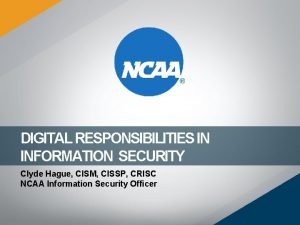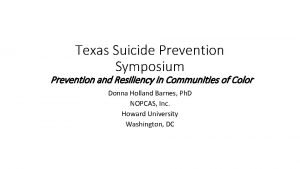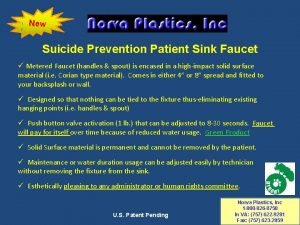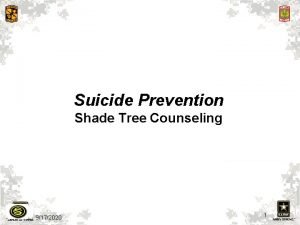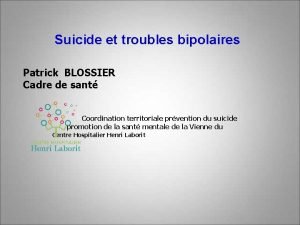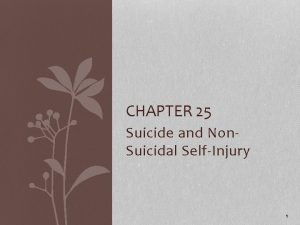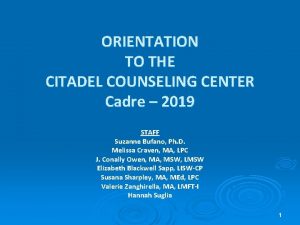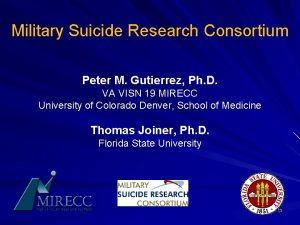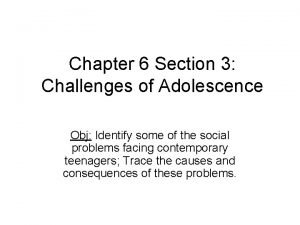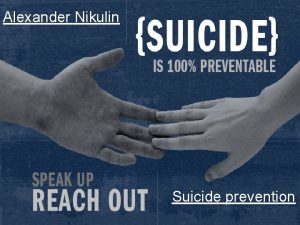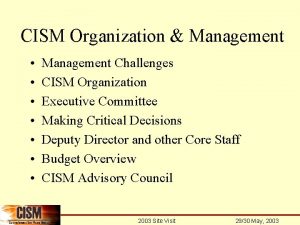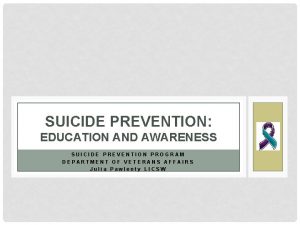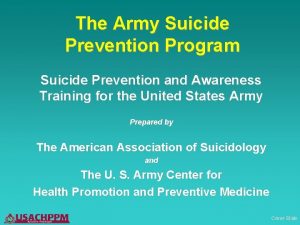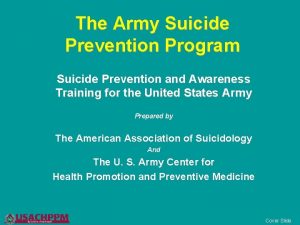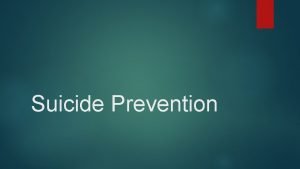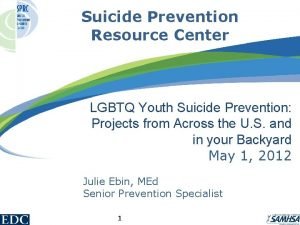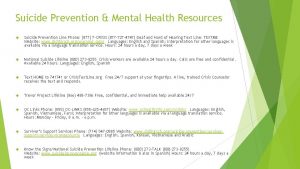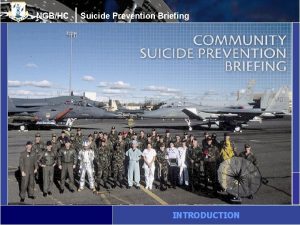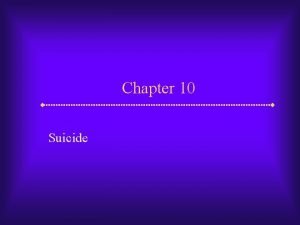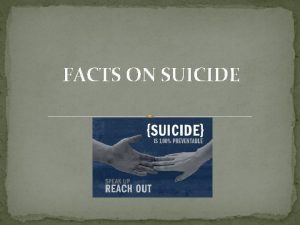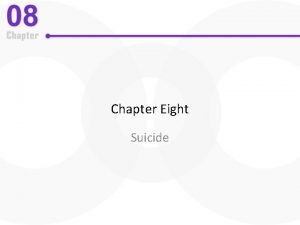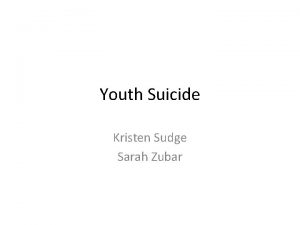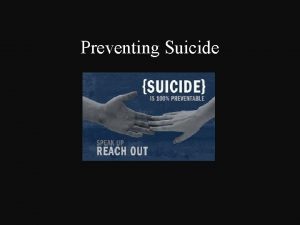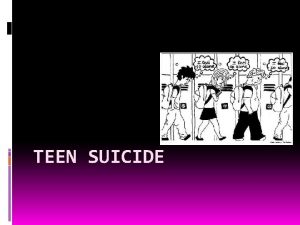CISM AND SUICIDE PREVENTION SUICIDE PREVENTION THIS IS





















- Slides: 21

CISM AND SUICIDE PREVENTION

SUICIDE PREVENTION THIS IS A SUBJECT WE DON’T LIKE TO TALK ABOUT BUT WE AS FIREFIGHTERS ARE AT RISK!

STATISTICS • These always have to start with statistics. There is really one important statistic and that is the largest population that is at risk for Suicide are males 15 -35! You may have heard different stats indicating higher rates for fire and police but if you look at who traditionally fills the majority of positions in these professions , it is exactly that high risk group !

RISK • Some demographics are at higher risk statistically but Suicide affects all genders and races. No one group is immune. It is a multidimensional confluence of factors. Things stack up at work and home, tunnel vision develops on the negative aspects of life, an overwhelming hopelessness develops. It becomes a crisis of options! “There is no other Choice “

RISK • There are circumstances that can put us at higher risk. If we know and recognize them we have a much better chance to intervene early before someone feels like they are “out of options “ • Big risk factors: diagnosis of a serious disease, divorce or end of any significant relationship, substance abuse, social isolation, and thoughts and verbalization of an organized plan.

RISK • If you look at the statistics for firefighters, the divorce rate is high, the cancer rate is high, alcohol abuse is high! That list looks very familiar. Alcohol is involved in a large number of suicides. It lowers inhibition and clouds judgement. It is a huge risk factor! Couple those risk factors with years of repeated exposure to traumatic, emotional situations you can see how our risk factors could quickly move us to the higher range on the graph. Suicide is the focus here because it is very serious but all these factors contribute to our overall health , physically and mentally, as well.

THE GOOD NEWS STATISTICS CAN BE DEPRESSING BUT EARLY INTERVENTION AND A GOOD SUPPORT SYSTEM IS VERY EFFECTIVE! Type to enter a caption.

SUPPORT • Our job puts us in a unique position to help each other. Few coworkers spend as much time together, interacting on calls, training and teaching each other, preparing meals, working out, watching movies, it offers us a much more personal connection than probably any other profession. We refer to our coworkers as brothers and sisters and literally hold each other’s lives in our hands. Not trying to be too dramatic but it is a little different than sitting next to someone in a cubical. We tend to know one another more closely and know when someone is going through situations that are in the high risk category. It does not have to be as extreme as suicidal ideation that moves us to intervene. If you are struggling with any issue , ask for help!

BARRIERS • As close as we are there are still barriers to communication, especially when it comes to subjects like depression, anxiety, or Suicide. A stigma exists still when addressing aspects of mental health that doesn’t seem to affect other parts of our health continuum.

SUPER HERO • A firefighter‘s can do attitude and the public‘s perception of us as strong, capable, heroes are a wonderful thing. They help us do what we need to on a daily basis for our community but the same mentality can be a barrier to communication and a barrier to seeking help.

• B A R R I E R S No fear • Tough • Never give up • Face a problem and deal with it • Don’t ask for help , we are the help • Strong • These are all wonderful attributes to live up to but the fear of not living up to these traditional qualities can be a huge barrier to asking for help. Buck it up, don’t show weakness, life is tough get over it, We are even told “don’t bring problems home “. A lot of advice is thrown around that just isn’t helpful or in many cases is just wrong. The intentions may be good but it contributes to the idea that we are on our own when it comes to dealing with problems in our personal life. You are not on your own!

THERE ARE OPTIONS ASK FOR HELP IF YOU NEED IT

NEVER ON OUR OWN • Have a firefighter get physically injured or sick and we rally around them, encouraging them in their recovery, helping their families, donating time and money in a way that no other group of people ever do. This is a wonderful benefit of being a part of the amazing firefighting community. Unfortunately the stigma of depression, anxiety or suicidal ideation cuts us off from this vital resource for recovery. We need to change our preconceptions about mental health issues and approach them with the same enthusiastic support we give our members who have sustained physical assault!

SIGNS AND SYMPTOMS • We are trained in the recognition of signs and symptoms of many life threatening disorders. We treat them successfully in the field daily. We can do the same thing with our fellow firefighters daily if we commit to recognizing the signs and symptoms of Suicide and commit to facilitating treatment.

RECOGNITION • One of the myths about Suicide is that it happens without warning. 90% of the time there are warning signs. There is a continuum of behaviors that if we recognize we can intervene early and make a difference. • Ideation: thinking about Suicide (myth: mentioning Suicide will provoke it, if they are having thoughts already they may respond to someone acknowledging it) • Gesture: may mention or verbalize thought of idea , verbalize a plan , this is a cry for help, risk taking (usually we dismiss as a bad joke or ignore it) • Attempt: (myth: the person is always intent on dying) They want help but don’t know how to get it , the attempt forces it to the forefront , myth: once suicidal always suicidal , most often acute for 12 -72 hours • Completion : intervention at any point above could get someone the help they need

DON’T OF INTERVENTION • Like contraindications sometimes it is good to know what Not to do: • Don’t offer empty promises “I’m sure it will be better after a good nights sleep “ • Don’t just try to cheer up “you have it better than most “ • Don’t debate morality “ it just doesn’t help and may be a good motivation not to , if they believe it is a sin • Don’t leave alone “call me tomorrow if you still feel bad”

THE DO’S OF INTERVENTION • Be direct • Remain calm • Accept their feelings • Rephrase thoughts • Stay close • Emphasis on the temporary nature of the problem • Explore resources Instill Hope! Help is available! • Listen

MORE ON THE DO’S • Be direct: we do this on calls all the time , ask our patients the question “do you want to hurt yourself? ” Could you ask a friend? A coworker? This is a life threatening situation so don’t be cryptic, just ask. • Be calm: if they say yes they want help, be calm and get them help • Accept their feelings: this sounds touchy feels it just means don’t be dismissive of what they are going through, it is a true crisis to them, realize that.

THE DO’S • Stay close: Don’t leave the person alone, don’t promise to keep it a secret • Emphasize the temporary nature: Reassurance that help is available and suicidal feelings are temporary • Resources: EAP, Suicide help line , peer support

EAP : 1888 -327 -2400 National Suicide helpline: 1 800 -273 -8255 Peer Support Members TAKE CARE OF EACH OTHER

LET’S COMMIT TO TAKING CARE OF EACH OTHER. IT DOESN’T HAVE TO BE AS SERIOUS AS SUICIDE TO REACH OUT FOR HELP IF YOU NEED IT. PEER SUPPORT MEMBERS, EAP , FRIENDS, AND FAMILY ARE ALL HERE WITH OUR BEST INTERESTS IN MIND. STAY SAFE OUT THERE.
 Primary prevention secondary prevention tertiary prevention
Primary prevention secondary prevention tertiary prevention Spectre cism
Spectre cism Cap ground team handbook
Cap ground team handbook Gcr cism
Gcr cism Mad acronym suicide prevention
Mad acronym suicide prevention Withdrawal glencoe
Withdrawal glencoe Suicide prevention chain teach
Suicide prevention chain teach Texas suicide prevention symposium
Texas suicide prevention symposium Suicide prevention sink
Suicide prevention sink Shadetree army
Shadetree army Prévention du suicide
Prévention du suicide Suicide prevention month quotes
Suicide prevention month quotes Army suicide prevention training
Army suicide prevention training Prévention suicide
Prévention suicide Chapter 25 suicide and nonsuicidal self injury
Chapter 25 suicide and nonsuicidal self injury Suicide girls sara calixto
Suicide girls sara calixto Citadel counseling center
Citadel counseling center Youth suicide research consortium
Youth suicide research consortium Rvguev death
Rvguev death Icd 10 fraktur klavikula
Icd 10 fraktur klavikula Egoistic suicide
Egoistic suicide Social integration by emile durkheim
Social integration by emile durkheim

